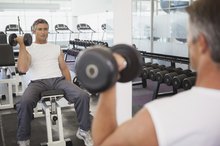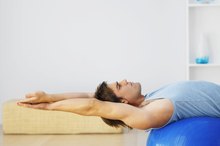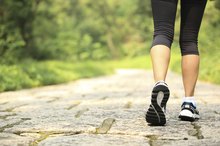More Articles
- Exercises for the Lower Spine Locked in a Right Rotation
- Activities to Avoid With Spinal Stenosis
- Which Increases My Heart Rate the Most, Jumping Jacks, Sit Ups or Running in Place?
- Physical Therapy Procedures for Pinched Nerves in Lumbar Vertebrae
- The Effects of Weight Lifting on Degenerative Disc Disease
Exercises That Aggravate Sciatica
Sciatica is a painful condition that affects your lower back, causing the spinal discs of your lumbar vertebrae to slip out of place and press on your sciatic nerve, which runs from your lower back down each leg. When you experience sciatica, symptoms can range from back pain and tingling to pain and numbness that radiates down your legs. Exercise for the most part can help sciatica sufferers relieve muscle pain and stiffness. However, certain exercises can harm, not help you. While you may need to speak to your physician about your individual exercise needs, there are some general exercises sciatica sufferers should avoid.
High-Impact Exercises
The suitability of most cardiovascular exercises can be determined based on the level of impact when your foot hits the ground. Walking is a low-impact exercise while running is a high-impact one. If you suffer from sciatica, you should avoid high-impact exercises that can aggravate your condition. While your feet and knees absorb shock when your foot hits the ground, this shock still radiates up to your lower back. This can further push a slipped spinal disk out of place. In addition to running, high-impact exercises include activities like football, soccer and basketball, which incorporate running. In some instances, vigorous aerobics like step aerobics also can aggravate sciatica.
- The suitability of most cardiovascular exercises can be determined based on the level of impact when your foot hits the ground.
- If you suffer from sciatica, you should avoid high-impact exercises that can aggravate your condition.
Twisting Exercises
Exercises for the Lower Spine Locked in a Right Rotation
Learn More
While twisting exercises may not always be high impact exercises, they put pressure on your spine in a different manner. Repetitive twisting can hurt the lower back and place increased pressure on your sciatic nerve. Twisting exercises include golf, ballet and football. Some weightlifting exercises, such as a twisting arm chop, in which you lift a weight in the air, then bring it down in the opposite direction, also can aggravate your sciatica.
- While twisting exercises may not always be high impact exercises, they put pressure on your spine in a different manner.
Russian Deadlift and Variations
The Russian deadlift is a weightlifting exercise where you place a barbell or hand weights on the floor and lift the weights from a standing position. For a person with sciatica, this can have aggravating effects on the lower back. “Our lumbar spines were not meant to pick things up with a straight-leg posture,” said Dr. Raymond Reiter, team physician for the New Jersey Nets interviewed on ESPN.com. “The knees must be bent.” If you must perform the Russian deadlift, keep your knees bent. However, even this position may place too much strain on the lower back. Avoid similar exercises that involve picking heavy items from the ground, which will likely strain your lower back.
- The Russian deadlift is a weightlifting exercise where you place a barbell or hand weights on the floor and lift the weights from a standing position.
- For a person with sciatica, this can have aggravating effects on the lower back.
- “
Improperly Performed Exercises
Activities to Avoid With Spinal Stenosis
Learn More
Sciatica sufferers tend to feel better when they lean forward, such as on a bicycle or in straight posture positions. These tend to place less pressure on the sciatic nerve. So when you perform an exercise with your back in a “C” curve or in other improper positions, you can harm the back. Any exercise, when improperly performed, can be painful to sciatica sufferers. Avoid lifting heavy weights, which can cause your back to buckle, and ask for help if you are unsure of the proper form for an exercise.
- Sciatica sufferers tend to feel better when they lean forward, such as on a bicycle or in straight posture positions.
- Any exercise, when improperly performed, can be painful to sciatica sufferers.
Related Articles
References
- Spine-Health: Sciatica Exercises for Sciatica Pain Relief; Ron S. Miller, PT; Dec. 14, 2000
- "The New York Times" Health Guide: Sciatica Exercise and Physical Therapy
- Spine-Health: Exercise for Sciatica from Degenerative Disc Disease
- Spine-Health; Myths About Sciatica Treatment Options; Ron S. Miller, PT; Dec. 14, 2000
- ESPN.com; Sciatica; Dr. Raymond D. Reiter
- Davis D, Maini K, Vasudevan A. Sciatica. [Updated 2020 Jan 25]. In: StatPearls [Internet]. Treasure Island (FL): StatPearls Publishing; 2020 Jan-. Available from: https://www.ncbi.nlm.nih.gov/books/NBK507908/
- Giuffre BA, Jeanmonod R. Anatomy, Sciatic Nerve. [Updated 2020 Mar 11]. In: StatPearls [Internet]. Treasure Island (FL): StatPearls Publishing; 2020 Jan-. Available from: https://www.ncbi.nlm.nih.gov/books/NBK482431/
- Davis D, Maini K, Vasudevan A. Sciatica. [Updated 2020 Jan 25]. In: StatPearls [Internet]. Treasure Island (FL): StatPearls Publishing; 2020 Jan-.
- Giuffre BA, Jeanmonod R. Anatomy, Sciatic Nerve. [Updated 2020 Mar 11]. In: StatPearls [Internet]. Treasure Island (FL): StatPearls Publishing; 2020 Jan-.
- National Institute of Neurological Disorders and Stroke. Low Back Pain Fact Sheet. Updated August 13, 2019. ninds.nih.gov
- Verwoerd AJH, Mens J, El Barzouhi A, Peul WC, Koes BW, Verhagen AP. A diagnostic study in patients with sciatica establishing the importance of localization of worsening of pain during coughing, sneezing and straining to assess nerve root compression on MRI. Eur Spine J. 2016;25(5):1389–1392. doi:10.1007/s00586-016-4393-8
- Koes BW, van Tulder MW, Peul WC. Diagnosis and treatment of sciatica. BMJ. 2007;334(7607):1313–1317. doi:10.1136/bmj.39223.428495.BE
- Chen MR, Wang P, Cheng G, Guo X, Wei GW, Cheng XH. The warming acupuncture for treatment of sciatica in 30 cases. Journal of Traditional Chinese Medicine 2009 29(1):50-3.
- Lawrence DJ, Meeker W, Branson R, Bronfort G, Cates JR, Haas M, Haneline M, Micozzi M, Updyke W, Mootz R, Triano JJ, Hawk C. Chiropractic management of low back pain and low back-related leg complaints: a literature synthesis. Journal of Manipulative and Physiological Therapeutics 2008 31(9):659-74. doi:10.1016/j.jmpt.2008.10.007
- Bell J. Massage therapy helps to increase range of motion, decrease pain and assist in healing a client with low back pain and sciatica symptoms. Journal of Bodywork and Movement Therapies 2008 12(3):281-9. doi:10.1016/j.jbmt.2008.01.006
Writer Bio
Rachel Nall began writing in 2003. She is a former managing editor for custom health publications, including physician journals. She has written for The Associated Press and "Jezebel," "Charleston," "Chatter" and "Reach" magazines. Nall is currently pursuing her Bachelor of Science in Nursing at the University of Tennessee.









